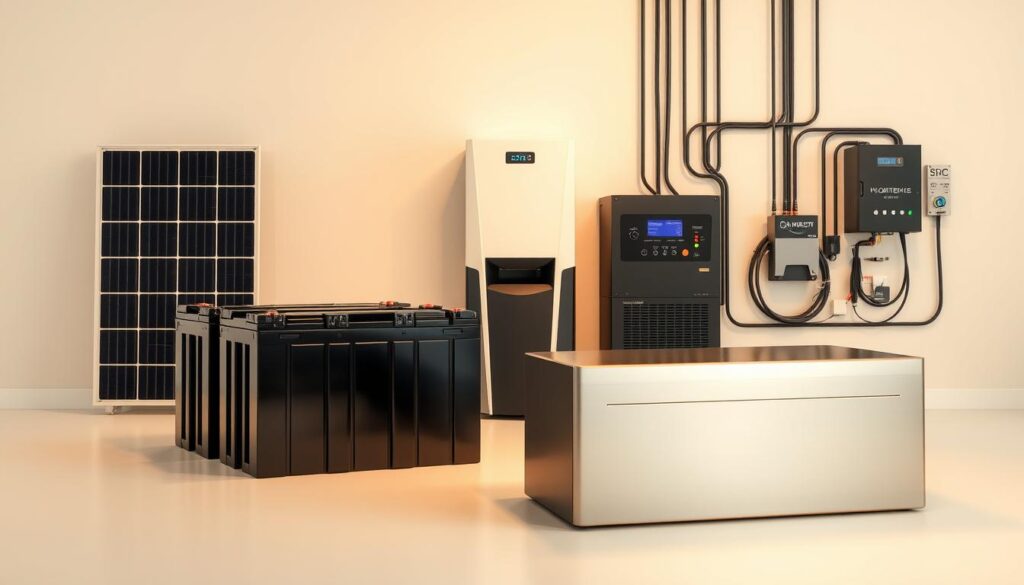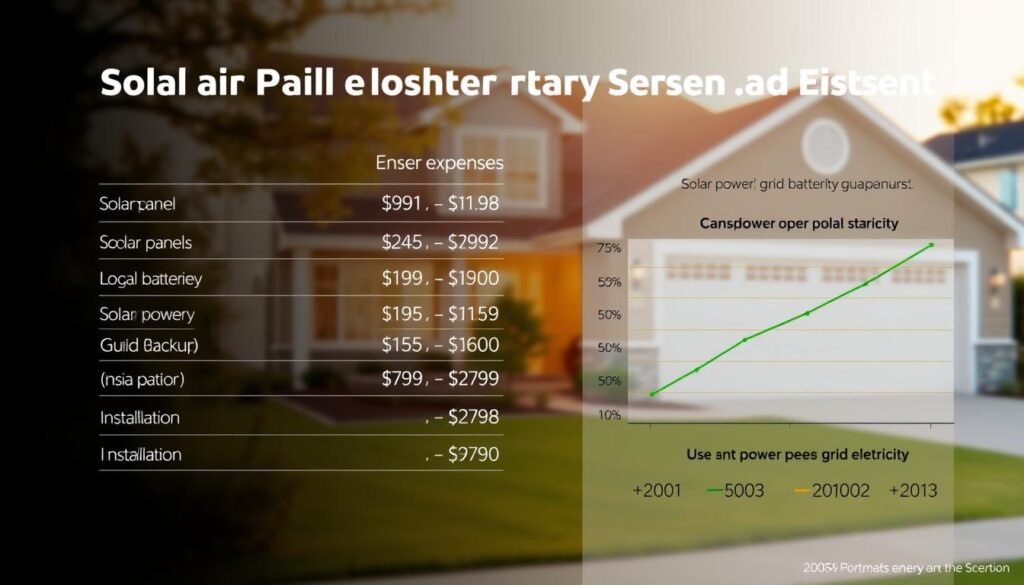More homeowners are turning to home solar systems with battery to cut energy costs and secure reliable power. These systems pair solar panels with storage, letting you save unused sunlight as electricity for later. Residential solar energy storage solutions like HomeGrid’s U.S.-built batteries offer up to 38.4 kWh, making energy independence achievable. Whether avoiding grid outages or trimming bills, these systems convert sunlight into usable power, storing it in lithium-ion or lead-acid batteries.
HomeGrid’s 4.8 kWh modules, built in America, come with a 10-year warranty and 10,000 cycle lifespan. Their batteries work with most inverters, ensuring your home stays powered even during blackouts. With 95% efficiency and LFP chemistry for safety, these systems provide clean energy while reducing reliance on traditional grids.
Key Takeaways
- Home solar systems with battery store excess energy for use during outages or night.
- HomeGrid’s U.S.-manufactured batteries range from 4.8 kWh to 38.4 kWh capacity.
- Batteries like HomeGrid’s offer 95% efficiency, converting sunlight into usable AC power.
- These systems help reduce electricity bills and lower carbon footprints.
- Modular designs let you expand storage as energy needs grow.
Understanding Home Solar Systems with Battery Storage
An effective solar battery system for home combines solar panels and batteries to capture sunlight and store energy for later use. This setup offers flexibility whether you stay connected to the grid or aim for independence. Let’s break down how these systems work and their options.
What Is a Solar Battery System?
A solar battery system for home includes panels, batteries, inverters, and a management system. Panels convert sunlight into electricity, while batteries store excess energy. This stored power can run lights, appliances, or charge devices even when the sun isn’t shining.
How Solar Energy Storage Works
- Solar panels generate DC electricity during daylight hours.
- Excess energy charges the battery via an inverter, converting it to usable power.
- Stored energy powers your home at night or during outages.
Grid-Tied vs. Off-Grid Solar Systems
| System Type | Grid-Tied | Off-Grid Solar System |
|---|---|---|
| Grid Connection | Connected to local utility | No grid connection |
| Best For | Homeowners with existing utility service | Rural areas or energy-independent lifestyles |
| Storage Use | Reduces electric bills | Powers the home 100% independently |
Lithium-ion batteries dominate the market due to their 95% depth of discharge and 10+ year lifespan. For those choosing an off-grid solar system, pairing multiple batteries ensures consistent power. Whether grid-tied or off-grid, these systems empower homeowners to take control of their energy use.
Benefits of Installing Residential Solar Battery Storage
Switching to residential solar battery storage unlocks savings and sustainability. These systems let you store unused solar energy in batteries, cutting reliance on the grid. Homeowners in states like California now benefit from NEM 3.0 rules, which reward those with home solar power storage by offering better rates for stored energy. Imagine using stored power during peak hours when utility rates spike—this alone can slash bills by 20-30% annually.
- Financial Gains: Federal tax credits (30% through 2032) and state rebates like California’s SGIP program reduce upfront costs.
- Environmental Impact: Solar batteries cut carbon emissions by replacing fossil fuel energy, aligning with clean energy goals.
- Resilience: During outages, these systems power essentials for hours, unlike noisy generators. Enphase Encharge batteries, for instance, last 10+ years—twice as long as many generators.
“By 2030, solar battery adoption could grow 6-7 times, driven by cost drops and policy shifts,” says Alex Lepore of Fortress Power.
Homeowners also gain control over energy use. Storing daytime solar output means avoiding peak-time utility fees. Over 10 years, this can save thousands compared to grid-only plans. Plus, homes with these systems see property values rise, making them a smart long-term investment.
Switching to home solar power storage isn’t just eco-friendly—it’s a practical step toward lower bills and energy freedom. With warranties up to a decade and federal incentives, now’s the time to start saving.
Components of a Complete Home Solar Power Storage System

A home solar power storage system combines key parts to turn sunlight into usable energy. The solar panel with battery backup setup includes four core elements: panels, batteries, inverters, and monitoring tools. Each part works together to maximize energy efficiency and reliability.
Solar Panels are the heart of any system. Monocrystalline panels are top choices due to their high efficiency (20-22%), fitting smaller rooftops. Polycrystalline options are budget-friendly but less efficient (15-17%). Thin-film panels are the least efficient but flexible for unconventional spaces. All panels come with 25–30-year warranties.
Batteries store excess energy. Home solar power storage systems use lithium-ion (long lifespan, 80-90% capacity after 10 years) or lead-acid (cheaper but shorter-lived). Lithium iron phosphate (LiFePO4) is a safer lithium option. A 10kW system paired with a 10kWh battery can power essentials during outages.
| Battery Type | Lifespan | Efficiency | Cost |
|---|---|---|---|
| Lithium-ion | 10-15 years | 90-95% | $$ |
| Lithium Iron Phosphate | 10-12 years | 85-90% | $$ |
| Lead-Acid | 3-5 years | 80-85% | $ |
Inverters convert DC energy to AC for home use. String inverters are cost-effective for standard setups. Microinverters optimize individual panel output, ideal for shaded roofs. Hybrid inverters add battery management, enabling backup during outages. Pair this with a charge controller to prevent battery overcharging.
Monitoring apps like Tesla’s Energy app or Sungage’s dashboard track real-time production, costs, and battery health. These tools flag issues early, ensuring peak performance. Professional installation ensures compliance with local codes and maximizes system efficiency.
Choosing the Right Solar Battery System for Your Home
Choosing the right solar battery system for home starts with understanding your household’s daily energy use. Review your utility bills to identify peak usage times and seasonal changes. For example, a 3-bedroom home using 30 kWh daily might pair well with a Bluetti EP900, which delivers 9kW output and offers 8.8, 17.6, or 26.4 kWh capacities. The Tesla Powerwall 3, with its 13.5 kWh capacity and 11.5 kW power, is another top choice for homes needing reliable backup during outages.
“Matching battery capacity to daily usage ensures optimal performance,” says Cape Fear Solar Systems, noting their 75% attach rate for storage in new installations.
- Capacity & Power: A renewable energy storage solutions expert suggests calculating usable energy. Most lithium-ion batteries have 90% round-trip efficiency. A 10 kWh battery effectively provides 9 kWh of usable power.
- Space Matters: Install in a cool, dry location. Lithium-ion batteries need ventilation but save space compared to lead-acid alternatives. Outdoor setups require weather-resistant models.
- Longevity: Prioritize batteries with 4,000–6,000 cycles (like lithium-ion) over 300–500 cycles for lead-acid. Check warranties—many cover 10 years or 80% capacity retention.
Costs vary: smaller systems start at $10,000 installed, while high-capacity setups hit $20,000. Compare brands like Bluetti and Tesla, factoring in your budget and energy goals. Start with your needs, then let a pro design your perfect system.
Cost Analysis of Solar Panel Battery Backup Systems
Investing in a solar panel battery backup system involves upfront costs that vary based on system size and battery type. A basic 4.0 kW system with a 10 kWh battery starts around $22,877, while larger 16 kW systems can reach $64,917. These prices include equipment and installation, but additional costs like electrical upgrades or permits may apply.

- Tesla Powerwall 2: $8,400 (13.5 kWh)
- LG 10H Prime: $6,000 (9.6 kWh)
- SonnenCore+: $10,300 (10 kWh)
Installation adds $1,500–$3,500, while inverters cost $1,500–$4,000. Homeowners in states like California can reduce costs by 20–30% through state incentives. The federal tax credit cuts costs by up to 30%, saving thousands on systems like the home solar battery backup.
Long-term savings start after 5–7 years. A household spending $200 monthly on electricity could save $1,200–$1,440 annually. Battery lifespans of 10–15 years ensure sustained returns. Urban installations may cost 15–25% more than rural setups due to labor rates.
With prices projected to drop 16–67% by 2050, now is a strategic time to invest. Start planning your energy savings today!
Federal and State Incentives for Renewable Energy Storage Solutions
Maximize savings on residential solar energy storage with government-backed programs. From tax credits to rebates, these incentives make clean energy accessible. Let us break down how to leverage these opportunities effectively.

Federal Tax Credits
The Investment Tax Credit (ITC) offers up to 30% off system costs through 2032. For example, a $18,000 battery setup could save $5,400. This credit phases down gradually, so act before rates drop.
State-Specific Programs
Explore state-specific rebates:
| State | Program | Max Savings |
|---|---|---|
| California | SGIP | $2,700+ per battery |
| Connecticut | ESS | $16,000 for homes |
| Massachusetts | ConnectedSolutions | 50% upfront financing |
| New York | LI Energy Storage | $250 per kWh rebates |
Utility Company Programs
- Dynamic tariffs for reduced electricity bills
- Shared savings programs with local providers
- Free installation offers for qualifying systems
Pair incentives to slash costs by 90%. For instance, a Tesla Powerwall could drop from $6,700 to $5,960 after rebates. Our team handles paperwork, ensuring you qualify for every available program. Don’t wait—many state funds are limited and competitive.
Installation Process and What to Expect
Installing a home solar system with battery involves several steps, but professional installers simplify the journey. Start by partnering with certified experts like IronRidge, known for durable mounting systems, to ensure safety and efficiency. Let’s break down the key phases:
Finding Qualified Installers
- Look for NABCEP-certified technicians and companies with manufacturer partnerships.
- Ask for references, view past projects, and verify insurance coverage.
- Compare quotes from at least three providers to ensure competitive pricing.
Permitting Requirements
Before installation begins, permits are essential. Key steps include:
| Permit Type | Purpose |
|---|---|
| Building Permit | Ensures structural compliance |
| Electrical Permit | Approves wiring and grid connections |
| HOA Approval | Required if your community has restrictions |
Typical Installation Timeline
From contract to completion, the process averages 2–6 months. Key phases:
| Phase | Duration |
|---|---|
| Site assessment & design | 1–2 weeks |
| Permitting | 2–6 weeks (varies by location) |
| Installation day | 1–3 days |
| Utility inspection & activation | 1–2 weeks |
Pro tip: Schedule installations during mild weather to avoid delays. Most systems are operational within 6 months, but upfront planning speeds up the process. Always confirm local net metering rules to maximize savings on your home solar battery backup investment.
Maintenance and Longevity of Home Solar Battery Backup
Regular upkeep ensures your home solar battery backup system operates efficiently for decades. Modern systems like the Dura5, with LiFePO4 cells, deliver up to 8,000 cycles, maintaining 80% capacity even after years of use. Proper care extends their lifespan beyond basic expectations.
- Check battery terminals yearly for corrosion—apply non-hardening sealant to prevent degradation.
- Monitor depth of discharge (DoD): keep lithium-ion systems below 80% and lead-acid below 50% for optimal longevity.
- Ensure your solar panel battery backup stays within temperature limits: lithium-ion handles -10°C to 140°F, while lead-acid prefers 40°F–80°F.
“Regularly balancing battery banks and avoiding partial discharges can add 30% to service life.”
Warranties often cover 10,000+ cycles for lithium systems, but real-world lifespan depends on usage. Flooded batteries require distilled water top-ups every 6–12 months, while sealed units need only software updates and charge controller checks. Avoid adding new batteries to a bank older than one year, as mismatched voltages cause premature failure.
Extreme temperatures reduce capacity—batteries lose 25% output at 30°F. Use charge controllers with temperature compensation to adjust voltage automatically. Proper sizing matters too: aim for a PV array 30% larger than daily load to account for efficiency losses.
With mindful use and annual professional inspections, your solar battery system can outlast warranties. Prioritize full recharges every three weeks to slow corrosion and maintain battery health. Small steps today ensure decades of clean, reliable energy tomorrow.
Conclusion: Powering Your Future with Residential Solar Energy Storage
Residential solar energy storage offers a practical path to energy independence and cost savings. Systems like the FranklinWH aPower battery, with its 13.6 kWh capacity, provide reliable backup while cutting reliance on the grid. Pairing solar panels with aPower’s scalable setups—up to 204 kWh when stacked—lets homes store surplus energy for days when sunlight is limited. This flexibility aligns with Washington’s growing shift toward renewable energy storage solutions, where eco-conscious homeowners benefit from tax exemptions and rebates.
The Dura5 Solar Battery exemplifies how modern systems balance affordability and longevity. With warranties up to 10 years and lifespans stretching 15–30 years, these systems pay for themselves over time. By storing solar energy, households avoid peak-hour utility rates, saving up to 50% on bills in high-cost states. Washington’s focus on reducing emissions by 2030 makes adopting these technologies both ethical and economical.
Looking ahead, innovations like vehicle-to-home charging and virtual power plants promise even greater integration. Lithium-ion tech continues improving, driving down costs and boosting efficiency. For homeowners, starting small with a home energy audit or contacting installers is the first step. Washington’s utilities now offer net metering programs and federal ITC credits, lowering upfront costs by up to 30%.
Every solar battery installed reduces demand for fossil fuels, shrinking the nation’s carbon footprint. With storage costs projected to drop further, now is the time to join the shift. Together, these choices create a resilient grid and a greener future. Explore local incentives, compare models like FranklinWH and Dura5, and join the thousands already powering homes with renewable energy storage solutions. Your decision today shapes a brighter tomorrow—for your wallet and the planet.
